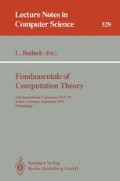Abstract
In the wake of the resolution of the four color conjecture, the graph reconstruction conjecture has emerged as one focal point of graph theory. This paper considers the computational complexity of decisions problems (deck checking and legitimate deck), the construction problems (preimage construction), and counting problems (preimage counting) related to the graph reconstruction conjecture. We show that:
-
1
deck checking ℓ m graph isomorphism ℓ m legitimate deck, and
-
2
if the graph reconstruction conjecture holds, then graph isomorphism ≡iso/l deck checking.
Relatedly, we display the first natural GI-hard NP set lacking obvious padding functions. Finally, we show that legitimate deck, preimage construction, and preimage counting are solvable in polynomial time on planar graphs, graphs with bounded genus, and partial k-trees for fixed k.
Research supported in part by the National Science Foundation under grants CCR-8809174/CCR-8996198 and CCR-8957604.
Preview
Unable to display preview. Download preview PDF.
References
J.L. Balcazar, J. Diaz, and J. Gabarro. Structural Complexity. Springer, Berlin, Vol. 1, 1988; Vol. 2, 1990.
C. Berge. Graphs. Amsterdam, 1985.
H.L. Bodlaender. Polynomial algorithms for chromatic index and graph isomorphism on partial k-trees. Technical report, Rijksuniversitet, June 1987.
J.A. Bondy. On Ulam's conjecture for separable graphs. Pacific J. Math., 31:281–288, 1969.
J.A. Bondy and R.L. Hemminger. Graph reconstruction—a survey. J. Graph Theory, 1:227–268, 1977.
G. Chartrand, V.H. Kronk, and S. Schuster. A technique for reconstructing disconnected graphs. Colloq. Math., 27:31–34, 1973.
P.Z. Chinn. A graph with ρ points and enough distinct (ρ-2)-order subgraphs is reconstructible. In Recent Trends in Graph Theory, LNM 186, pages 71–73. Springer, Berlin, 1971.
P.F. Dietz. Intersection Graph Algorithms. PhD thesis, Computer Science Dept., Cornell University, Ithaca, NY, 1984.
W. Doerfler. Some results on the reconstruction of graphs. In Infinite and Finite Sets, pages 361–383. North-Holland, Amsterdam, 1975. Colloq. Math. Soc. Janos Bolayi, Vol. 10.
M.R. Garey and D.S. Johnson. Computers and Intractability: A Guide to the Theory of NP-Completeness. Freeman, San Francisco, 1979.
D. Geller and B. Manvel. Reconstruction of cacti. Canad. J. Math., 21:1354–1360, 1969.
W.B. Giles. The reconstruction of outerplanar graphs. J. Combinatorial Theory Ser. B, 16:215–226, 1974.
S. Goldwasser and M. Sipser. Private coints versus public coints in interactive proof systems. In Proceedings of the 18th ACM Symposium on Theory of Computing, pages 59–68, 1986.
M.C. Golumbic. Algorithmic Graph Theory and Perfect Graphs. Academic Press, New York, 1980.
D.L. Greenwell and R.L. Hemminger. Reconstructing graphs. In The Many Facets of Graph Theory, pages 91–114. Springer, Berlin, 1969.
D.K. Gupta. Reconstruction conjecture for square of a tree. In Graph Theory, LNM 1073, pages 268–278. Springer, Berlin, 1984.
F. Harary. On the reconstruction of a graph from a collection of subgraphs. In Theory of Graphs and its Applications, pages 47–52. Prague, 1964.
F. Harary. Graph Theory. Massachusetts, 1969.
F. Harary. A survey of the reconstruction conjecture. In Graphs and Combinatorics, LNM 406, pages 18–28. Springer, Berlin, 1974.
J. Hartmanis. On log-tape isomorphisms of complete sets. Theoret. Comput. Sci., 7:273–286, 1978.
D.S. Johnson. The NP-completeness column: An ongoing guide. J. Algorithms, 6:434–451, 1985.
D. Joseph and P. Young. Some remarks on witness functions for non-polynomial and non-complete sets in NP. Theoret. Comput. Sci., 39:225–237, 1985.
P.J. Kelly. A congruence theorem for trees. Pacific J. Math., 7:961–968, 1957.
R. Ladner and N. Lynch. Relativization of questions about log space computability. Mathematical Systems Theory, 10(1):19–32, 1976.
R. Ladner, N. Lynch, and A. Selman. A comparison of polynomial time reducibilities. Theoretical Computer Science, 1(2):103–124, 1975.
J. Lauri. Proof of Harary's conjecture on reconstruction of trees. Discrete Math., 43:79–90, 1983.
J. Lauri. Graph reconstruction—some techniques and new problems. Ars Combin., 24(B):35–61, 1987.
T. Long. Strong nondeterministic polynomial-time reducibilities. Theoretical Computer Science, 21:1–25, 1982.
B. Manvel. Reconstruction of unicyclic graphs. In Proof Techniques in Graph Theory, pages 103–107. Academic Press, New York, 1969.
B. Manvel. Reconstruction of maximal outerplanar graphs. Discrete Math., 2:269–278, 1972.
B. Manvel and J.M. Weinstein. Nearly acyclic graphs are reconstructible. J. Graph Theory, 2:25–39, 1978.
S. Micali and V.V. Vazirani. An O(V 1/2 E) algorithm for finding maximum matching in general graphs. In 21st Annual Symp. on Found. Comp. Sci., pages 17–27, New York, 1980.
C. St. J.A. Nash-Williams. The reconstruction problem. In Selected Topics in Graph Theory, pages 205–236. Academic Press, 1978.
U. Schöning. A low and high hierarchy in NP. J. Comput. System Sci., 27:14–28, 1983.
U. Schöning. Graph isomorphism is in the low hierarchy. J. Comput. System Sci., 37:312–323, 1988.
A. Selman. Polynomial time enumeration reducibility. SIAM Journal on Computing, 7(4):440–457, 1978.
S.M. Ulam. A Collection of Mathematical Problems. Interscience Publishers, New York, 1960.
M. von Rimscha. Reconstructibility and perfect graphs. Discrete Math., 47:79–90, 1983.
K. Wagner and G. Wechsung, Computational Complexity. Deutscher Verlag der Wissenschaften, Berlin, 1985.
A.T. White and L.W. Beineke. Topological graph theory. In Selected Topics in Graph Theory, Vol. 1, pages 15–49. New York, 1978.
P. Young. Juris Hartmanis: Fundamental contributions to isomorphism problems. In A. Selman, editor, Complexity Theory Retrospective, pages 28–58. Springer-Verlag, 1990.
Author information
Authors and Affiliations
Editor information
Rights and permissions
Copyright information
© 1991 Springer-Verlag Berlin Heidelberg
About this paper
Cite this paper
Kratsch, D., Hemachandra, L.A. (1991). On the complexity of graph reconstruction. In: Budach, L. (eds) Fundamentals of Computation Theory. FCT 1991. Lecture Notes in Computer Science, vol 529. Springer, Berlin, Heidelberg. https://doi.org/10.1007/3-540-54458-5_76
Download citation
DOI: https://doi.org/10.1007/3-540-54458-5_76
Published:
Publisher Name: Springer, Berlin, Heidelberg
Print ISBN: 978-3-540-54458-6
Online ISBN: 978-3-540-38391-8
eBook Packages: Springer Book Archive

